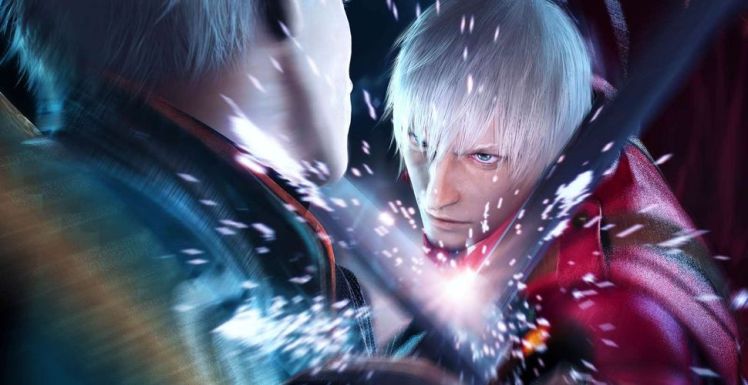
When Devil May Cry 3 released in the West in March 2005, reviews and forums alike were buzzing about the challenge it offered following the disappointment of Devil May Cry 2. In fact, it wasn’t uncommon for the game’s difficulty to be the very first thing mentioned in a review’s opening paragraph:
…to deny the fact that Capcom’s stellar sequel is one of the most challenging titles of the last ten years would either make you a robot with superhuman reflexes, or a videogame prodigy…
– IGN, 2005
As global players started talking about and sharing footage of the game, something didn’t seem to add up. It was becoming apparent that there were not only regional differences between the Eastern and Western releases of the game, but even between Western releases.
After thorough testing and investigation, we finally had our answer: Devil May Cry 3 in NTSC format (typically North America) was harder than the NTSC-J (typically Japan) and PAL (typically Europe and Australia) formats.
It’s quite common to see people asking why on forums, and it’s also quite common to see the answer being ‘it was simply an accident’. The evidence that’s used to support this is the release of Devil May Cry 3: Special Edition, a game which standardised the difficulty across all regions. However, this explanation just always seemed to bug me – it seemed like such an incomplete explanation.
Getting to the bottom of this is something that I’ve been doing on and off now for around thirteen years, so I felt that it was time to set aside some research time and finally try to solve the mystery that has been bugging me for over a decade.
To be crystal clear on the matter, I’ve challenged myself with two main questions:
- Was the difficulty difference in the American version of Devil May Cry 3 an accident?
- If not, why was it different?
So everyone, please sit back and enjoy. As usual, there will be a summary at the bottom if you don’t wish to read everything.
The Devil’s In The Detail
I’ll start off by addressing the question of whether the difficulty difference could have been an accident. To do this, I will explain exactly how the regional versions of the game differ.
The phrase that’s commonly used to describe the American difficulty is ‘a step above the other versions’. This means that American Easy is the other versions’ Normal, while American Normal is the other versions’ Hard. So let’s begin mapping it out:

Here we have a grid that represents the three versions of Devil May Cry 3. The original version of Devil May Cry 3 has four difficulties when we exclude Heaven or Hell: Easy, Normal, Hard and Dante Must Die. Extensive testing has shown that Dante Must Die mode is the exact same across all three regions, so we can complete the grid now.
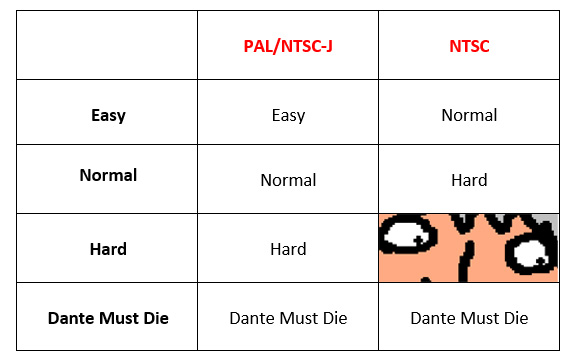
I think you can see where I’m going with this. What the hell is American Hard mode?
Unfortunately, there’s no real easy way to represent all of Devil May Cry 3’s difficulty coding in a diagram as the changes in each difficulty are quite complex. People have tried in the past by saying things like in Hard Mode, enemies have 75% more health. This is simply incorrect as enemies such as Hell Prides have been shown to have 250HP across all difficulties.
Instead, the most conceptually easy way I can represent the difficulties to you would be by looking at the base damage of the first hit of Dante’s Rebellion combo. This information comes courtesy of a Chinese move data list called Raising the Devil, brought to English users’ attention by Devil May Cry speedrunner BassOmegaX.
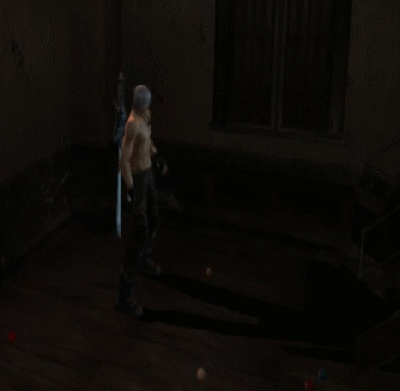
In Easy, the hit deals 200 damage. Normal is 100, Hard is 90, American Hard is 70 and Dante Must Die is 50.
Not only that, but Devil May Cry community veteran Pops translated the Raising the Devil data list for English users. It verifies that American Hard shares more similarities with Dante Must Die mode than any other difficulty.
American Hard was created as a difficulty that bridged the gap between Hard and Dante Must Die. This difficulty would later make it into Devil May Cry 3: Special Edition as Very Hard mode.
This leads me to my conclusion on the matter. We can see that someone had to sit down and programme damage values for every single move in the game, plus enemy placement patterns and AI for all enemies specifically for American Hard. This is not something that just happened by accident.
Was it an accident?: No.
So now we move on to the second question. I’ve come to my conclusion that Devil May Cry 3 was made deliberately harder for America due to having to programme a unique Hard mode for the region. So now I have to put my money where my mouth is and figure out why this was done deliberately.
The Devil’s In The Disappointment
To begin, I must go all the way back to Devil May Cry 1. When the Devil May Cry HD Collection was released, Capcom were praised for ‘fixing’ the control scheme of the first game as people found jumping with Triangle to be awkward. However, Capcom didn’t ‘fix’ it per se, they just used a version that ‘wasn’t broken’.
Believe it or not, the original Japanese version of Devil May Cry actually used X to jump and Triangle for melee. For proof, here is a screenshot of the control scheme.
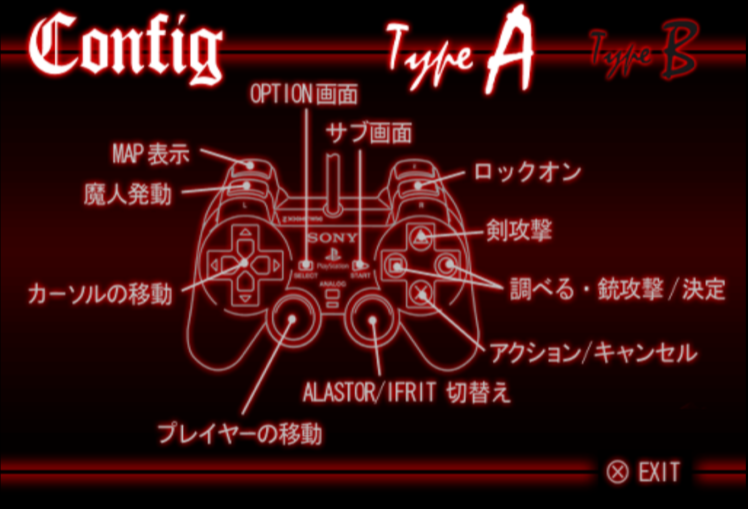
Capcom decided to use the Japanese version of DMC1 for the HD release and injected the English text into the game. This decision led people to believe that they had become action game gods:
I played DMC1 HD at a friend’s house last night, and I swear it felt easier than the original version…Does anyone else feel like they toned down the difficulty? Or did I just magically get better at this game…?
– Yoshi006, 2012
The answer in this case is the former.
Here we cut back to our friend BassOmegaX. After comparing both the Japanese and American versions of Devil May Cry via RAM watching, he came to this conclusion:
In DMC1 USA, Dante’s attacks do 80% of the damage compared to the JPN version on Normal and Hard mode…In addition, Dante takes 20% more damage from regular enemies compared to the JPN version on all modes, including DMD.
– BassOmegaX, 2015
So there we have it, Devil May Cry 1 was made artificially harder in Western regions compared to its Japanese counterpart.
When it was time to make Devil May Cry 2, Capcom rolled out a global survey on Devil May Cry 1 to see what changes they could implement into the sequel. All regions complained about the game’s difficulty, which later resulted in Devil May Cry 2’s pathetic difficulty:
It seems somewhere along the line that Capcom took the criticism of DMC being too hard for the casual audience and went completely the other way, making it harder to die than not…right now we’re praying that the challenge ramps up soon, or else this is in serious danger of being labelled one of the easiest games of all time…
– Eurogamer, 2003
Unfortunately, the difficulty never did ramp up, and Western reviewers and players alike were especially cut-throat about it:
Our first impressions six weeks ago seemed to confirm these reports that the game was almost embarrassingly easy for anyone in possession of two functioning thumbs.
– Eurogamer, 2003
Wanting to avoid the mistake of making another game that was too easy, it seems that Capcom made the decision to make a sequel harder than Devil May Cry 2, while following in Devil May Cry 1’s footsteps of making it easier for the Japanese market. This would explain the Eastern vs Western difficulty difference, but not the NTSC-PAL difference within the West.
This is simultaneously the most interesting part of the story and the part that nobody other than myself has figured out. If you’ll stay with me, I can explain to you why Europe received Devil May Cry 3’s Japanese difficulty settings rather than America’s.
The Devil’s In The Difficulty
It all started in E3 2004, the first time anyone outside of Japan gets to play Devil May Cry 3. The reception from American journalists was overwhelmingly positive and they couldn’t seem to get enough of the game.
…with waits that took as long as an hour before journalists had their opportunity to play. To say that DMC3 was creating some immense buzz would be an exercise in stating the obvious…We only wish that we had more time to experience Devil May Cry 3 than what we were given.
– IGN, 2004
Four months later, a demo version of Devil May Cry 3 was available as a preorder bonus for Resident Evil Outbreak: File 2 in Japan. Outlets such as GameSpot and MeriStation imported this demo to get a further fix of Devil May Cry goodness. While both outlets were very complimentary of the demo, GameSpot said something intriguing:
The boss battle was significantly more difficult than anything else that we encountered in the demo…It’s also conceivable, of course, that the demo has deliberately been made less challenging up to that point so that anyone who plays it will get to see the boss in action.
– GameSpot, 2004
GameSpot suspected that the difficulty of the demo was made artificially easier, perhaps even being set to Easy. This made me curious – was the demo indeed set to Easy?
The Devil’s In The Demo
As previously stated, the Devil May Cry 3 demo was a preorder bonus in Japan rather than something exclusive to journalists. This meant that your average Josuke could get their hands on it and put it online for people to play.
That’s exactly what happened. The demo, titled ‘Devil May Cry 3 Trial Ver.’, is available to download as an ISO if you know where to look. I downloaded it and conducted extensive testing on it.
The first thing that came to mind when investigating was the double damage multiplier on the first hit of Rebellion between Easy and Normal. Remember that Hell Prides have 250HP on all difficulties? If the demo were set to Easy, you would only need to hit Hell Prides with the first hit of Rebellion twice to kill them. If it were any higher than Easy, you would need 3+ hits. Let’s show this in equation form.
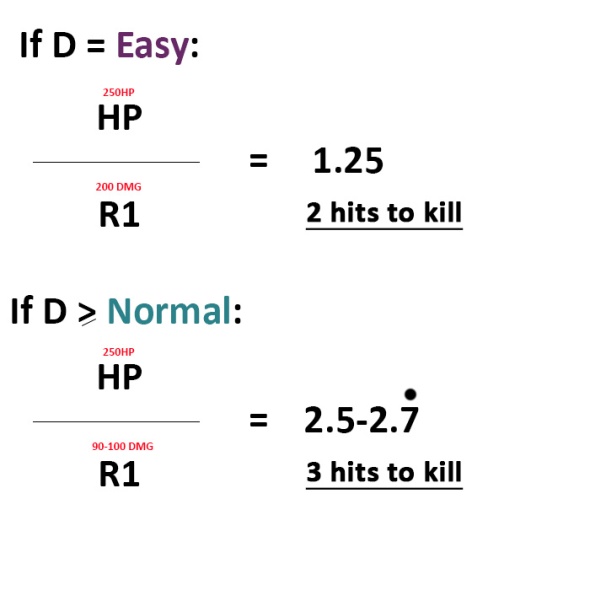
After testing, Hell Prides in the demo required three hits to kill. This means that the demo was not made artificially easier as suspected by GameSpot.
Figuring out whether it was set to Normal or Hard was a little trickier. Both Normal and Hard Hell Prides would require three hits to kill. I also tested enemy amounts in Mission 1 and they were the exact same in the demo, retail Normal and retail Hard: 17 Hell Prides and 6 Hell Lusts.
I re-visited Raising the Devil and saw that Hell Lusts had 750HP. This allowed me to explore whether the demo was set to Normal or Hard. Cue equations.
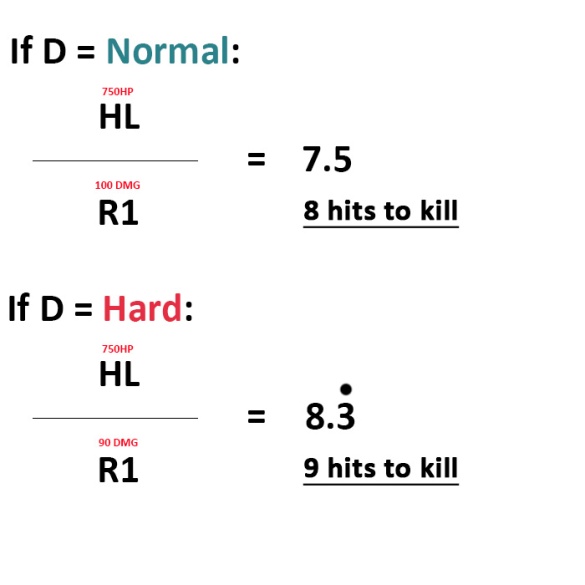
Hell Lusts in the demo required eight hits to kill, confirming that the demo was set to the difficulty that would be known as European/Japanese Normal and American Easy.
Now I know what you’re thinking at this point – what about Europe?
The Devil’s In The Dilemma
At this point, we have a demo that launched in Japan and positive press primarily in North America and Mexico, but not much from Europe. To correct this, Devil May Cry 3 producer Tsuyoshi Tanaka was tasked with taking the game across Europe two months before its Western release. How did European players react to the game?
They were struggling.
An article on Tanaka’s European journey was featured in Jeux France, now known as Gamekyo. This article contains an integral piece to the puzzle once translated to English:
Tsuyoshi Tanaka indicates that Devil May Cry 3: Dante’s Awakening is very difficult compared to other parts of the series, at least that’s what the English players have found during the presentation of the game in London. Capcom is trying to rectify.
– Jeux France, 2005
Capcom is trying to rectify. European players found the game too difficult and Capcom said they would fix it.
This article not only demonstrates that European players were playing the full game as opposed to the demo, but it shows the play conditions that they were allowed:
- The title screen is the exact same as the American retail version (European version here, note the logo change). Compare this to the trial version.
- The UI is the exact same as the retail version. Compare this to the trial version.
- There is a picture of the Hell Vanguard fight. This fight is missing from the demo.
- The Jeux France article references the number ‘6’ hidden in the opening cutscene of Mission 6. The demo ends at Mission 2, technically 3 in the retail version as Missions 2 and 3 were combined for the demo.
- European players were allowed to play the game with maxed out health, access to Devil Trigger, a maxed out Devil Gauge and fully levelled up Styles. The demo has limited health, Styles at base level and no access to Devil Trigger.
Why is it important that they are playing the full game instead of the demo? Because it shows two things. Firstly, it shows that they were not just playing the demo that was set to Japanese Normal/American Easy. Secondly, judging by the use of the American title screen rather than the final European title screen, it looks like European players were playing an American build of the game complete with its Western difficulty settings.
If European players were struggling with America’s difficulty with full health, access to Devil Trigger and maxed out Styles, it makes sense that Capcom’s promised rectification would be to give Europe the easier Japanese settings instead.
So what about America? With Tanaka gaining this feedback two months before the Western release and the game needing to go gold soon, Capcom have to make the decision of whether to allocate time and resources to similar testing in America and potentially risk delaying the game. It would make sense for Capcom to research attitudes within the American press when making this decision. When they do so, they would see an article from GameSpot calling Japanese Normal, the difficulty they are now giving Europe and considering giving America, easy.
With the American press already calling Japanese Normal easy, fearing negative backlash for easy difficulty à la Devil May Cry 2, and fearing potential delays to conduct field testing in America, the decision was made to maintain the Western difficulty in America while keeping the promise to Europe to deliver an easier game.
Thank you very much for reading and happy gaming!
Summary
- While Devil May Cry 3’s difficulty differences were previously believed to be an accident, this isn’t possible as American Hard had to be programmed from scratch. This difficulty later made it into Devil May Cry 3: Special Edition as Very Hard mode.
- The Devil May Cry series has a history of being made artificially harder for the West compared to the East. When the decision was made to make Devil May Cry 2 easier for everyone, it was critically panned particularly in the West: reviewers referred to it as “one of the easiest games of all time”. When it was time to make Devil May Cry 3, Capcom returned to their philosophy of easier in the East, harder in the West.
- In September 2004, a demo for Devil May Cry 3 was included as a preorder bonus for Resident Evil Outbreak: File 2 in Japan. Outlets such as GameSpot and MeriStation imported this demo, with GameSpot stating that they suspected the demo had been made artificially easier than the final product.
- After extensive testing, I concluded that the demo was not made artificially easier – it was set to Japanese Normal.
- With Devil May Cry 3 receiving comparatively little press in Europe, producer Tsuyoshi Tanaka was tasked with taking the game across Europe to gain player feedback just two months before the game’s commercial release.
- Despite having many luxuries (full health, Devil Trigger, max level Styles etc.) that were not present in the Japanese demo, European players massively struggled. Tanaka promised players that Capcom would rectify this, eventually giving Europe and Australia the easier Japanese difficulty settings instead of the original Western difficulty settings.
- With Devil May Cry 3 needing to go gold soon, Capcom had to decide whether to conduct similar field testing in America and potentially risk delaying the game. When making their decision, they would see the American press referring to Japanese Normal as easy. Fearing delays and backlash for its easier difficulty à la Devil May Cry 2, the decision was made for America to retain its Western difficulty settings and give Europe/Australia the promised easier difficulty settings.
Note
This article was a segue from my usual work on The Psychology of Video Games, a series which bridges the gap between academia and gaming. If you would like to support both/either: a) my attempts to destroy the narrative that gaming causes violence and depression, or b) my tireless efforts to bring you all well-researched content such as this article, please consider keeping me caffeinated through my Ko-Fi link below. Thank you!

“The boss battle was significantly more difficult than anything else that we encountered in the demo…It’s also conceivable, of course, that the demo has deliberately been made less challenging up to that point so that anyone who plays it will get to see the boss in action.” – GameSpot, 2004
From what I understood, Vanguard wasn’t in the demo, and instead the first boss was Cerberus. if so, this report makes a lot of sense, as at least for me, the first time you face Cerberus is a difficulty peak in the game, and this should only be reinforced if you don’t face vanguard along the way.
LikeLike
Hi there.
I considered the lack of Vanguard in the demo, but I have no evidence that is able to distinguish between Capcom deliberately removing Vanguard vs Capcom not making the decision to place Vanguard there yet. What I will say is that I probably would have weighed this absense more heavily if Vanguard did not become a regular enemy just a few missions later.
Vanguard as an enemy serves three purposes: to show players that moves can be parried with well-timed strikes, to show the value of evasive moves such as dodging, and to showcase the importance of audio cues through its very obvious bell-striking audio cue. When considering all of this, the fight is quite fair. When I considered other set pieces in the demo (a corridor of Enigmas with spawning Wraths, Sloths which teleport to you to attack), it’s hard for me to view Vanguard, an educational tool that soon becomes a regular enemy, as something that would make the demo significantly harder.
In saying that, I didn’t want to use the scapegoat of ‘Vanguard is absent, that’s why the journalist said the demo was easy’ as I wanted to thoroughly investigate the demo. Investigating the difficulty of the demo allowed me to evidence my earlier claim that Japan was supposed to have an easier difficulty than the West. This then leads on to Europe playing the Western difficulty and struggling while America never got the chance to properly test out the Western difficulty. I hope my perspective on this is clearer now.
LikeLike
What I mean is that the journalist found the boss hard compared to the rest of demo, not because the demo was too easy, but rather because Cerberus is hard, and made him feel like there was an imbalance between the mission and the boss. I particularly didn’t struggle in my first playthrough until I met Cerberus.
LikeLike
I understand that, but the journalist then wrote in his article that he suspected that the demo had “deliberately been made less challenging”. I understand that people find Cerberus challenging, but it was that claim of tampering with the game’s difficulty for the demo that I wished to investigate. Since I had no leads on the potential deliberate removal of the Vanguard enemy, I instead investigated the tampering of the overall difficulty.
LikeLike
Dang, nice article.
LikeLike
Thank you!
LikeLike
Great article! I’d always heard the Japanese version of DMC3 was easier than the NA in terms of standard difficulty, but also in that they got Gold Mode in Dante’s Awakening, which we didn’t get until SE.
Historically, Japanese versions of games have been easier in terms of difficulty, but I could never figure out why that was. Castlevania 3 is an notable example of this and there are even sprites and music tracks that are different from the NA release.
LikeLike
This is game’s Journalism at it’s finest. Thank you for the Article
LikeLike